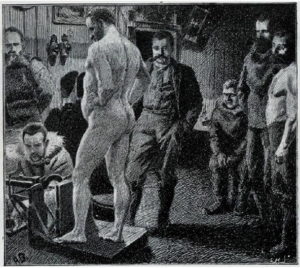Fighting weight
It looks as though we will start on our way tomorrow, Tuesday – and while we wait for the final go-ahead, we might as well have another meal.
 From Nansen’s Fram expedition: “The weight gain is still causing personal anxiety; some have gained up to 2 kg over the past month.” Illustration: Andreas Bloch, “Fram over polhavet” (“Farthest North”) From Nansen’s Fram expedition: “The weight gain is still causing personal anxiety; some have gained up to 2 kg over the past month.” Illustration: Andreas Bloch, “Fram over polhavet” (“Farthest North”)
It’s important to put on enough weight, we’ve been told. This well-intentioned advice comes from polar travellers who have experienced how the kilos melt away in the Antarctic wastelands. Cecilie Skog weighed just 44 kilos at the end of her last expedition. And Vegard has personal experience of what it’s like to lose 14 kilos in fourteen days, which is what happened to him when he crossed Greenland.
So we have done our homework. We have eaten at dawn and at dusk. Between meals and before dinner. Eaten large amounts of food we would ordinarily avoid or eat only sparingly. Tall, thin Jan-Gunnar has been working diligently for two years and is mighty pleased about the little bulge at his midriff and the 92 kilos shown by the bathroom scales. Stein got the nickname Short-Fatty before leaving home. And here in Chile we have ample opportunity to continue increasing our fighting weight. Big steaks and juicy Magellan mutton, dripping with fat.
Nansen was also eager to lay on some extra kilos before confronting the ice. Already at Egersund, on his way north with Fram in 1893, he wrote home to Eva that he was eating like a wolf and “filling out like a hippopotamus”. Nor did the crew of Fram suffer any deprivation. The first winter, Nansen wrote: “Have mercy on us! How will this end? Several of us look like pigs all fattened up for the slaughter, and Juell the cook is swelling something awful in both jowl and belly.” What if they were forced to evacuate: “...that paunch, by Jove, would be a terrible thing to drag across the ice if it should ever become necessary. Better start thinking about a starvation diet now.”
We have been in training for this expedition for several years. But at the moment we feel more like Juell the cook than hardened polar explorers. And maybe we feel a little of what Amundsen experienced when he moored Fram at the ice edge 14 January 1911: “Snow conditions were ideal. The skis ran smoothly and easily through the new-fallen snow. But not a one of us is “well-trained” after the long sea journey of five months, so our speed was not great.”
|